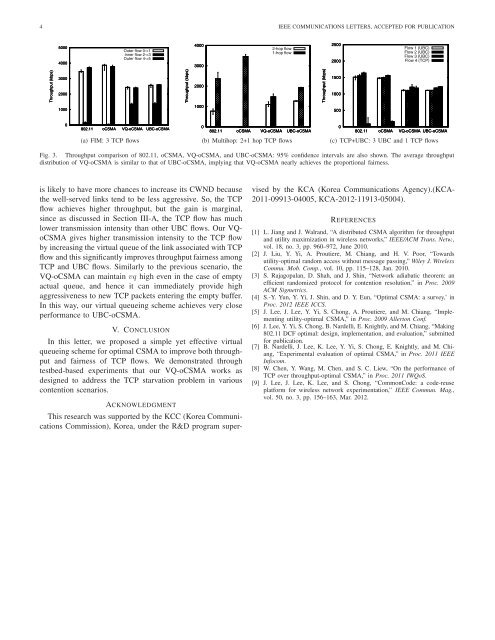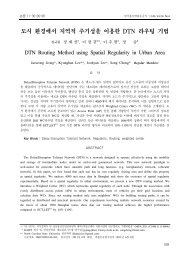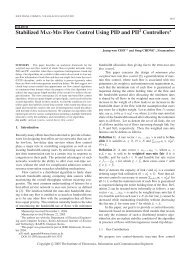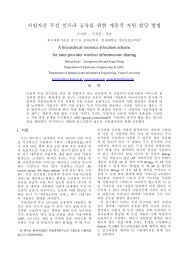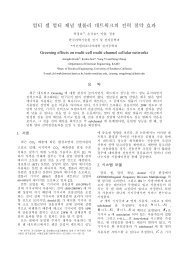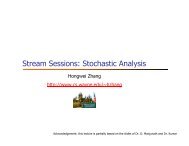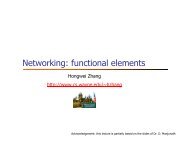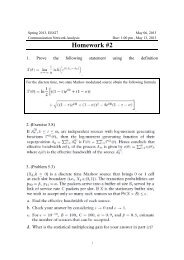Improving TCP Performance over Optimal CSMA in Wireless ... - KAIST
Improving TCP Performance over Optimal CSMA in Wireless ... - KAIST
Improving TCP Performance over Optimal CSMA in Wireless ... - KAIST
Create successful ePaper yourself
Turn your PDF publications into a flip-book with our unique Google optimized e-Paper software.
4 IEEE COMMUNICATIONS LETTERS, ACCEPTED FOR PUBLICATION<br />
Throughput (kbps)<br />
5000<br />
4000<br />
3000<br />
2000<br />
1000<br />
0<br />
Outer flow 0->1<br />
Inner flow 2->3<br />
Outer flow 4->5<br />
802.11 o<strong>CSMA</strong> VQ-o<strong>CSMA</strong> UBC-o<strong>CSMA</strong><br />
(a) FIM: 3 <strong>TCP</strong> flows<br />
Throughput (kbps)<br />
4000<br />
3000<br />
2000<br />
1000<br />
0<br />
2-hop flow<br />
1-hop flow<br />
802.11 o<strong>CSMA</strong> VQ-o<strong>CSMA</strong> UBC-o<strong>CSMA</strong><br />
(b) Multihop: 2+1 hop <strong>TCP</strong> flows<br />
Throughput (kbps)<br />
2500<br />
2000<br />
1500<br />
1000<br />
500<br />
0<br />
Flow 1 (UBC)<br />
Flow 2 (UBC)<br />
Flow 3 (UBC)<br />
Flow 4 (<strong>TCP</strong>)<br />
802.11 o<strong>CSMA</strong> VQ-o<strong>CSMA</strong> UBC-o<strong>CSMA</strong><br />
(c) <strong>TCP</strong>+UBC: 3 UBC and 1 <strong>TCP</strong> flows<br />
Fig. 3. Throughput comparison of 802.11, o<strong>CSMA</strong>, VQ-o<strong>CSMA</strong>, and UBC-o<strong>CSMA</strong>: 95% confidence <strong>in</strong>tervals are also shown. The average throughput<br />
distribution of VQ-o<strong>CSMA</strong> is similar to that of UBC-o<strong>CSMA</strong>, imply<strong>in</strong>g that VQ-o<strong>CSMA</strong> nearly achieves the proportional fairness.<br />
is likely to have more chances to <strong>in</strong>crease its CWND because<br />
the well-served l<strong>in</strong>ks tend to be less aggressive. So, the <strong>TCP</strong><br />
flow achieves higher throughput, but the ga<strong>in</strong> is marg<strong>in</strong>al,<br />
s<strong>in</strong>ce as discussed <strong>in</strong> Section III-A, the <strong>TCP</strong> flow has much<br />
lower transmission <strong>in</strong>tensity than other UBC flows. Our VQo<strong>CSMA</strong><br />
gives higher transmission <strong>in</strong>tensity to the <strong>TCP</strong> flow<br />
by <strong>in</strong>creas<strong>in</strong>g the virtual queue of the l<strong>in</strong>k associated with <strong>TCP</strong><br />
flow and this significantly improves throughput fairness among<br />
<strong>TCP</strong> and UBC flows. Similarly to the previous scenario, the<br />
VQ-o<strong>CSMA</strong> can ma<strong>in</strong>ta<strong>in</strong> vq high even <strong>in</strong> the case of empty<br />
actual queue, and hence it can immediately provide high<br />
aggressiveness to new <strong>TCP</strong> packets enter<strong>in</strong>g the empty buffer.<br />
In this way, our virtual queue<strong>in</strong>g scheme achieves very close<br />
performance to UBC-o<strong>CSMA</strong>.<br />
V. CONCLUSION<br />
In this letter, we proposed a simple yet effective virtual<br />
queue<strong>in</strong>g scheme for optimal <strong>CSMA</strong> to improve both throughput<br />
and fairness of <strong>TCP</strong> flows. We demonstrated through<br />
testbed-based experiments that our VQ-o<strong>CSMA</strong> works as<br />
designed to address the <strong>TCP</strong> starvation problem <strong>in</strong> various<br />
contention scenarios.<br />
ACKNOWLEDGMENT<br />
This research was supported by the KCC (Korea Communications<br />
Commission), Korea, under the R&D program super-<br />
vised by the KCA (Korea Communications Agency).(KCA-<br />
2011-09913-04005, KCA-2012-11913-05004).<br />
REFERENCES<br />
[1] L. Jiang and J. Walrand, “A distributed <strong>CSMA</strong> algorithm for throughput<br />
and utility maximization <strong>in</strong> wireless networks,” IEEE/ACM Trans. Netw.,<br />
vol. 18, no. 3, pp. 960–972, June 2010.<br />
[2] J. Liu, Y. Yi, A. Proutiere, M. Chiang, and H. V. Poor, “Towards<br />
utility-optimal random access without message pass<strong>in</strong>g,” Wiley J. <strong>Wireless</strong><br />
Commu. Mob. Comp., vol. 10, pp. 115–128, Jan. 2010.<br />
[3] S. Rajagopalan, D. Shah, and J. Sh<strong>in</strong>, “Network adiabatic theorem: an<br />
efficient randomized protocol for contention resolution,” <strong>in</strong> Proc. 2009<br />
ACM Sigmetrics.<br />
[4] S.-Y. Yun, Y. Yi, J. Sh<strong>in</strong>, and D. Y. Eun, “<strong>Optimal</strong> <strong>CSMA</strong>: a survey,’ <strong>in</strong><br />
Proc. 2012 IEEE ICCS.<br />
[5] J. Lee, J. Lee, Y. Yi, S. Chong, A. Proutiere, and M. Chiang, “Implement<strong>in</strong>g<br />
utility-optimal <strong>CSMA</strong>,” <strong>in</strong> Proc. 2009 Allerton Conf.<br />
[6] J. Lee, Y. Yi, S. Chong, B. Nardelli, E. Knightly, and M. Chiang, “Mak<strong>in</strong>g<br />
802.11 DCF optimal: design, implementation, and evaluation,” submitted<br />
for publication.<br />
[7] B. Nardelli, J. Lee, K. Lee, Y. Yi, S. Chong, E. Knightly, and M. Chiang,<br />
“Experimental evaluation of optimal <strong>CSMA</strong>,” <strong>in</strong> Proc. 2011 IEEE<br />
Infocom.<br />
[8] W. Chen, Y. Wang, M. Chen, and S. C. Liew, “On the performance of<br />
<strong>TCP</strong> <strong>over</strong> throughput-optimal <strong>CSMA</strong>,” <strong>in</strong> Proc. 2011 IWQoS.<br />
[9] J. Lee, J. Lee, K. Lee, and S. Chong, “CommonCode: a code-reuse<br />
platform for wireless network experimentation,” IEEE Commun. Mag.,<br />
vol. 50, no. 3, pp. 156–163, Mar. 2012.


